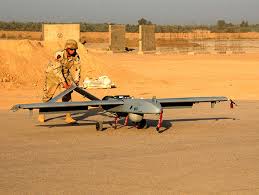As reported by Network World: The Defense Advanced Research Projects Agency (DARPA) has moved along a
project it says would use hot-spot enabled drones to bring bring wireless
communications to even the most distant and harsh environment.
The project known as Fixed Wireless at a Distance is designed specifically to overcome the challenge inherent with cell communication in remote areas and this week the agency awarded L-3 $16.4 million to support the next iteration of the system.
The award announcement states: If successful, the phase 2 effort is expected to deliver a package consisting of radio and router pods that can be mounted on Shadow unmanned aerial vehicles, with all mobile hotspots subsystems wholly contained within the pods.
 According to DARPA, the program looks to address the challenge of data
transmission in remote areas and envisions a gigabit-per-second tactical
backbone network extending to all soldiers in a hostile location.
According to DARPA, the program looks to address the challenge of data
transmission in remote areas and envisions a gigabit-per-second tactical
backbone network extending to all soldiers in a hostile location.
"To achieve this, the program seeks to develop advanced pointing, acquisition and tracking (PAT) technologies, not commercially available, needed to provide high connectivity to the forward-located mobile hotspots. Advanced PAT technology is key for connectivity to small UAVs, for example, enabling them to serve as flying nodes on the mobile high-speed backbone."
 "While some advanced commercial millimeter-wave components can be leveraged
for this program, the technical challenge is more complex given the
infrastructure and terrain challenges of a forward-operating locations," DARPA
stated. "Mobile Hotspots will require the development of steerable antennas,
efficient millimeter-wave power amplifiers, and dynamic networking to establish
and maintain the mobile data backhaul network. We anticipate using commercial
radio protocols, such as WiFi, WiMax or LTE [Long Term Evolution], as a
cost-effective demonstration of the high-capacity backbone. However, the
millimeter-wave mobile backbone developed during this program will be compatible
with other military radios and protocols."
"While some advanced commercial millimeter-wave components can be leveraged
for this program, the technical challenge is more complex given the
infrastructure and terrain challenges of a forward-operating locations," DARPA
stated. "Mobile Hotspots will require the development of steerable antennas,
efficient millimeter-wave power amplifiers, and dynamic networking to establish
and maintain the mobile data backhaul network. We anticipate using commercial
radio protocols, such as WiFi, WiMax or LTE [Long Term Evolution], as a
cost-effective demonstration of the high-capacity backbone. However, the
millimeter-wave mobile backbone developed during this program will be compatible
with other military radios and protocols."
The project known as Fixed Wireless at a Distance is designed specifically to overcome the challenge inherent with cell communication in remote areas and this week the agency awarded L-3 $16.4 million to support the next iteration of the system.
The award announcement states: If successful, the phase 2 effort is expected to deliver a package consisting of radio and router pods that can be mounted on Shadow unmanned aerial vehicles, with all mobile hotspots subsystems wholly contained within the pods.
"To achieve this, the program seeks to develop advanced pointing, acquisition and tracking (PAT) technologies, not commercially available, needed to provide high connectivity to the forward-located mobile hotspots. Advanced PAT technology is key for connectivity to small UAVs, for example, enabling them to serve as flying nodes on the mobile high-speed backbone."









